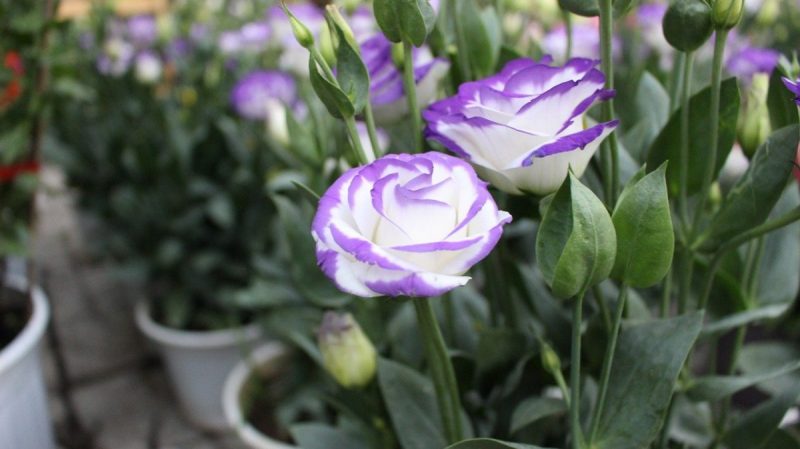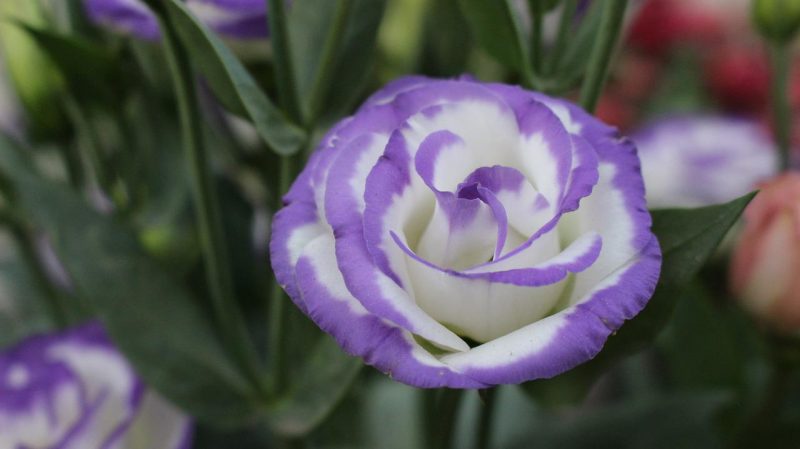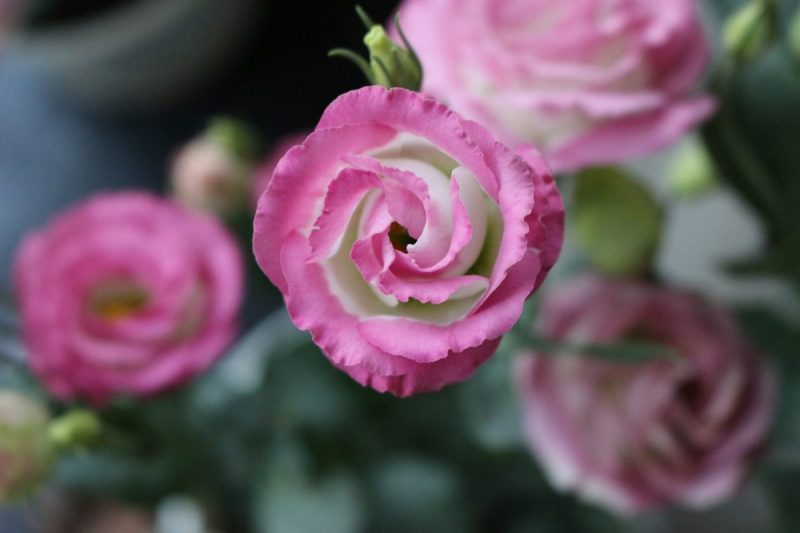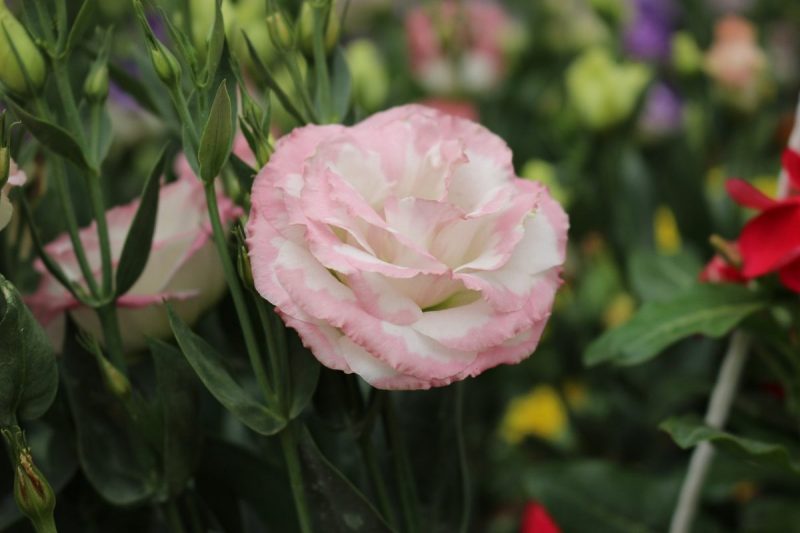Lisianthus, planting guide and care work

Lisianthus (Eustoma russellianum prev. Eustoma grandiflorum) is a herbaceous, perennial plant that is part of the Gentianaceae family, but it is frequently cultivated as an annual or biennial plant, being highly appreciated in floral arrangements. In the first stage, Lisianthus grows in the form of a rosette of leaves, and later it forms floral stems, which are 40-80 cm long. The stems are more or less branched in the topside and have blue-green, sessile leaves, being oppositely arranged.
The flowers are campanulate, simple or involute, arranged at the top of the stem branches and have a corolla composed of 5 glossy, velvety petals, colored in different shades of pink, purple, white, blue, but they can be unicolor or bicolor.
The fruits are yellow-white capsules and contain very small seeds.
Lisianthus – Varieties
There are many varieties of Lisianthus, which are distinguished by color and size. Most of them bloom in early summer, although more and more cultivars that continue to bloom during the warm summer months, until autumn, are being cultivated.
‘Balboa’: a variety with numerous flowers on the plant, all in shades of blue;
‘Flamenco’: a variety resistant to high temperatures;
‘Maurine’: a semi-dwarf variety, resistant to heat;
‘Sapphire Pink Rim’: a variety with a compact shape and white flowers with pink edges.
‘Echo Blue’: a variety with dark blue flowers, blooming from mid-summer until frost.



Environmental conditions
Light. Lisianthus has high demands in terms of light, so it is recommended to plant it in sunny places, where it can benefit from sunlight for at least 6-8 hours a day. Placing it in the sunniest places determines an accentuation of the ornamental qualities (color of flowers and foliage).
Temperature. Temperature requirements differ depending on the different stages of the plant’s growth and development, but as a rule it varies between 20-25 °C.
Soil. It prefers soils/substrates rich in organic matter, which ensure good water drainage. It is essential to have good drainage, since excessive, persistent moisture can lead to the rotting of the roots. Regarding the pH, Lisianthus cannot tolerate a very acidic or alkaline soil. To prevent the yellowing of the leaves, as well as a decrease in vigor, it is recommended that the pH be maintained between 6.5 and 7.0.
Lisianthus – Care
Fertilizing. For a prolific/abundant flowering, Lisianthus also needs a balanced fertilization. Thus, in order to help the flowering process, it is necessary to regularly administer, throughout the vegetative growth period, fertilizers specially formulated for flowering plants.
Recommended products
-
You can find products on a different store
Change Store -
You can find products on a different store
Change Store -
You can find products on a different store
Change Store -
You can find products on a different store
Change Store -
You can find products on a different store
Change Store -
You can find products on a different store
Change Store -
You can find products on a different store
Change Store -
You can find products on a different store
Change Store -
You can find products on a different store
Change Store -
You can find products on a different store
Change Store -
You can find products on a different store
Change Store -
You can find products on a different store
Change Store -
You can find products on a different store
Change Store -
You can find products on a different store
Change Store -
You can find products on a different store
Change Store -
You can find products on a different store
Change Store -
You can find products on a different store
Change Store -
You can find products on a different store
Change Store -
You can find products on a different store
Change Store -
You can find products on a different store
Change Store -
You can find products on a different store
Change Store -
You can find products on a different store
Change Store -
You can find products on a different store
Change Store -
You can find products on a different store
Change Store
Watering. It prefers moist soils/substrates. Therefore, it is recommended that watering should be done moderately, when the first centimeters of soil/substrate have dried.
Propagation. It is done by seeds or cuttings. The seeds are usually sown in the autumn/winter months, because during that period, the risk of the “rosette” phenomenon is minimal. They are sown in alveolar trays/crates by spreading the seeds on the surface of the substrate (dampened in advance), then gently pressed. They will not be covered with soil because they need light to germinate.
The optimal temperature for seed germination is 20–25 °C, and it is recommended that the substrate be kept permanently damp. For the initial growth of seedlings, approximately 21–24 °C during the day and 15–18 °C at night are necessary. After about 7-8 weeks, the seedlings can be transplanted into individual flowerpots. They need to be kept in optimal conditions, until they are planted in the garden. Planting will be done later, in spring, only after the danger of late frosts and hoar has passed.
Recommended products
-
You can find products on a different store
Change Store -
You can find products on a different store
Change Store -
You can find products on a different store
Change Store -
You can find products on a different store
Change Store -
You can find products on a different store
Change Store -
You can find products on a different store
Change Store -
You can find products on a different store
Change Store -
You can find products on a different store
Change Store -
You can find products on a different store
Change Store -
You can find products on a different store
Change Store -
You can find products on a different store
Change Store -
You can find products on a different store
Change Store -
You can find products on a different store
Change Store -
You can find products on a different store
Change Store -
You can find products on a different store
Change Store -
You can find products on a different store
Change Store -
You can find products on a different store
Change Store -
You can find products on a different store
Change Store -
You can find products on a different store
Change Store -
You can find products on a different store
Change Store -
You can find products on a different store
Change Store -
You can find products on a different store
Change Store -
You can find products on a different store
Change Store -
You can find products on a different store
Change Store
Propagation by cuttings is a more difficult process and is done from 10-15 cm cuttings (with 3 pairs of leaves) that are rooted in a special substrate, using rooting stimulators.
Dormancy. In areas with a cold climate, when plants grown outside die at the first frost, it is recommended to remove them completely after the flowering period has ended or after they have dried due to low temperatures.
In areas with a milder climate (mild winters), where Lisianthus behaves like a perennial plant, it is recommended to cut the stems and wilted flowers and stop fertilizing during the winter.
Recommended products
-
You can find products on a different store
Change Store -
You can find products on a different store
Change Store -
You can find products on a different store
Change Store -
You can find products on a different store
Change Store -
You can find products on a different store
Change Store -
You can find products on a different store
Change Store -
You can find products on a different store
Change Store -
You can find products on a different store
Change Store -
You can find products on a different store
Change Store -
You can find products on a different store
Change Store -
You can find products on a different store
Change Store -
You can find products on a different store
Change Store -
You can find products on a different store
Change Store -
You can find products on a different store
Change Store -
You can find products on a different store
Change Store -
You can find products on a different store
Change Store -
You can find products on a different store
Change Store -
You can find products on a different store
Change Store -
You can find products on a different store
Change Store -
You can find products on a different store
Change Store -
You can find products on a different store
Change Store -
You can find products on a different store
Change Store -
You can find products on a different store
Change Store -
You can find products on a different store
Change Store
Diseases and pests
Lisianthus plants can be susceptible to various diseases (viruses, stem rot, Fusarium wilt) while among the pests, the most common are mites.
Additionally
- It can be grown both as a potted plant and in the garden, but it is recommended that the planting in the garden be done after the danger of late frosts and hoar has passed.
- In areas with a cold climate, if it is grown outside, it will perish at the first frost;
- It is considered a plant with high demands in terms of light intensity, with a high sensitivity to the excess or lack of water, as well as to drafts;
- They are plants very often used in different floral arrangements (for example, bouquets for brides);
- For abundant flowering, Lisianthus needs sufficient light, as well as proper fertilization and watering;
- As a rule, approximately 5-7 months are needed from sowing to flowering;
- In conditions of prolonged high temperatures, the plant will remain in the rosette phase, without developing floral stems, but various varieties and hybrids more or less tolerant to high temperatures have been created.















































































































































































































































































































































































































































